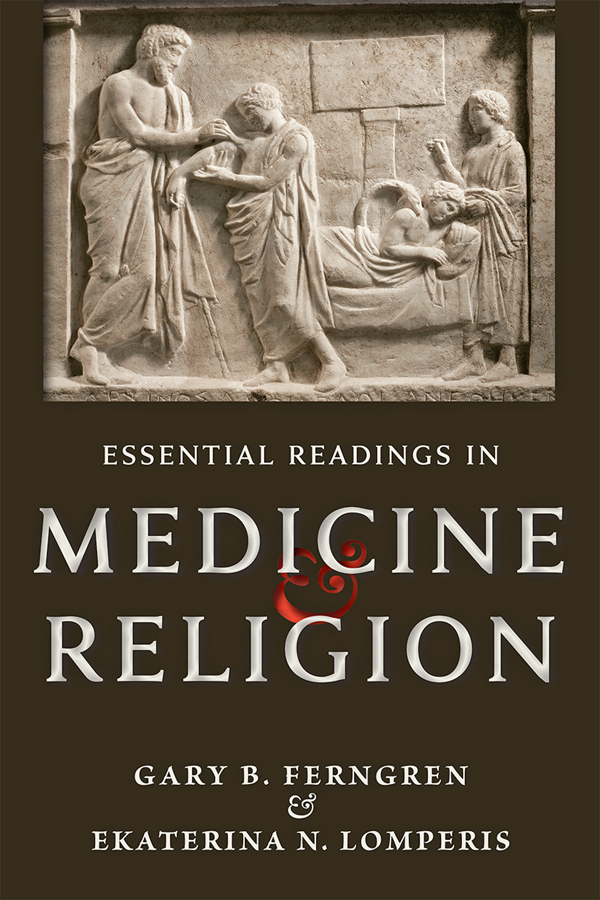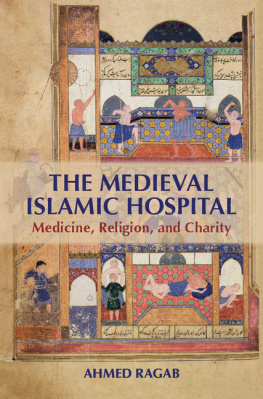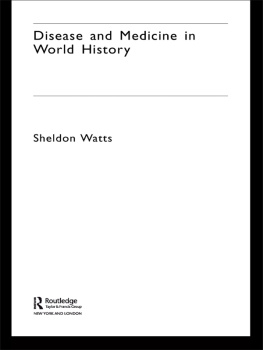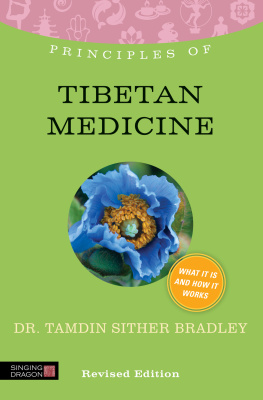Contents
Guide

ESSENTIAL READINGS IN MEDICINE AND RELIGION
ESSENTIAL READINGS IN MEDICINE AND RELIGION
Gary B. Ferngren and Ekaterina N. Lomperis
Johns Hopkins University Press
Baltimore
2017 Johns Hopkins University Press
All rights reserved. Published 2017
Printed in the United States of America on acid-free paper
2 4 6 8 9 7 5 3 1
Johns Hopkins University Press
2715 North Charles Street
Baltimore, Maryland 21218-4363
www.press.jhu.edu
Library of Congress Cataloging-in-Publication Data
Names: Ferngren, Gary B., editor. | Lomperis, Ekaterina N., 1983 editor. | Complemented by (work): Ferngren, Gary B. Medicine and religion.
Title: Essential readings in Medicine and religion / [edited by] Gary B. Ferngren and Ekaterina N. Lomperis.
Description: Baltimore : Johns Hopkins University Press, 2017. | Complemented by: Medicine and religion / Gary B. Ferngren. [2014]. | Includes bibliographical references and index.
Identifiers: LCCN 2016044785| ISBN 9781421422909 (pbk. : alk. paper) | ISBN 1421422905 (pbk. : alk. paper) | ISBN 9781421422916 (electronic) | ISBN 1421422913 (electronic)
Subjects: LCSH: MedicineReligious aspects. | MESH: Religion and Medicine | History of Medicine | Collected Works
Classification: LCC BL65.M4 E895 2017 | NLM BL 65.M4 | DDC 201/.661dc23
LC record available at https://lccn.loc.gov/2016044785
A catalog record for this book is available from the British Library.
Special discounts are available for bulk purchases of this book. For more information, please contact Special Sales at 410-516-6936 or specialsales@press.jhu.edu.
Johns Hopkins University Press uses environmentally friendly book materials, including recycled text paper that is composed of at least 30 percent post-consumer waste, whenever possible.
To my husband and son
EKATERINA LOMPERIS
To my grandchildren, James, Julian, Lexi, Max, Claire, Sophia, Amikha, Lilah, Cole, Alexander, Annalise, Andrew
GARY FERNGREN
CONTENTS
PREFACE
This book is intended as a companion volume to Medicine and Religion: A Historical Introduction (Johns Hopkins University Press, 2014), which traces the history of the relationship of medicine to religion from the earliest ancient Near Eastern societies to the twenty-first century. The purpose of this volume is to provide an extensive selection of texts that expand and illustrate the narrative of the earlier book. Because the earlier volume covers a broad chronological expanse, it proved impossible to incorporate more than a few primary texts for each historical era. Our intention here is to enhance Medicine and Religion s themes with a collection of primary sources that range in length from a few lines to several pages.
Our division of labor reflects our respective specialties in the history of medicine and religion. Gary Ferngren has assembled the texts and provided the commentary for (Islam); he offers here three new translations of texts not previously available in English [6.4, 6.5, 6.7].
This volume supplies a collection of texts and places them in their respective contexts in order to specifically address the historical relationships between medicine and religion. Several other collections feature sources for the history of medicine. But thus far there has not appeared an educational volume focusing on the intersection of medicine and religion that covers the entire chronological sweep from ancient to modern. We hope that our volume proves to be a useful introduction for students interested in this growing field. We are happy to acknowledge that we have been greatly helped by earlier collections of texts, from which we have drawn freely. Knowledgeable readers will observe that we have omitted many texts that might have been profitably included had greater space been available.
This book is not a history of either medicine or religion, but of the intersection of the two. The fact that we include few descriptions of solely natural or empirical medicine might give the impression that traditional cultures relied on religious healing to the exclusion of empirical therapy. That is not true, but, as our sources indicate, religion played many roles beyond that of healing, which medicine alone could not provide.
The eight chapters in this volume parallel the eight chapters in Medicine and Religion: A Historical Introduction. Each chapter begins with a brief introduction that provides a basic historical context for the intersection of medicine and religion in the period covered. A more detailed medical-historical background is, of course, provided by the earlier book. The texts are numbered sequentially within each chapter and preceded by a short paragraph that contextualizes the author and subject. Throughout the book, square-bracketed numbers point readers to specific texts. While we have not keyed each text to the subjects treated in Medicine and Religion , the parallel organization of the chapters will permit readers to connect the material here to the appropriate historical narrative given there. All of the excerpts have been reproduced as they were published in the cited sources, including parenthetical comments and square-bracketed insertions from the original editors; ellipses indicate where material has been omitted because of space considerations. In a few cases, the authors of this book inserted some words of clarification or slightly modified older translations (both changes are indicated by curly brackets). The bibliography gives full citations for the sources from which we have taken the texts included in this volume.
ACKNOWLEDGMENTS
We are grateful for the cooperation that has marked every phase of our collaborative work, during which each others expertise, intellectual openness, and friendship have meant much to both of us.
Ekaterina Lomperis is grateful for the erudition and expertise of the colleagues who took the time to read her chapters, in particular Michelle Harrington, Daniel Kim, Mark Lambert, and Father John Schroedel. Her work owes a great deal to their feedback. Special thanks are owed to her doctoral advisor, Susan E. Schreiner, who helped her more fully to appreciate the complexities of the histories of both religion and medicine. The Johns Hopkins University Press team, in particular editor Jacqueline Wehmueller, were outstanding in navigating the manuscripts preparation. Ekaterinas mother and grandmother, although many miles away, supplied warm encouragement and inspiration from across the ocean. Most of all, Ekaterina would like to thank her husband, without whose unlimited patience, unconditional love, and self-sacrificial support at every stage of the manuscript preparation this book would not have happened.
Gary Ferngren expresses his warm appreciation for all who aided in this project, especially his personal assistant, Joy McMurchy, and his editorial assistant, Celia Funk. Their dedication, expertise, and care at every stage of the manuscripts preparation lightened his load considerably and made possible the completion of the book in a timely manner. Thanks to Mark Geller, who made suggestions for ; and the anonymous readers of the press. As always, our editor, Jackie Wehmueller, and her staff at Johns Hopkins University Press have provided support and encouragement at every stage.
We also express our appreciation to the School of History, Philosophy, and Religion and to the Center for the Humanities and the Office of Research at Oregon State University, as well as to Johns Hopkins University Press, for grants to cover permission fees. Gary Ferngren acknowledges the grant of a sabbatical leave for the spring term of 2015, which materially aided in the writing and editing of this volume.







